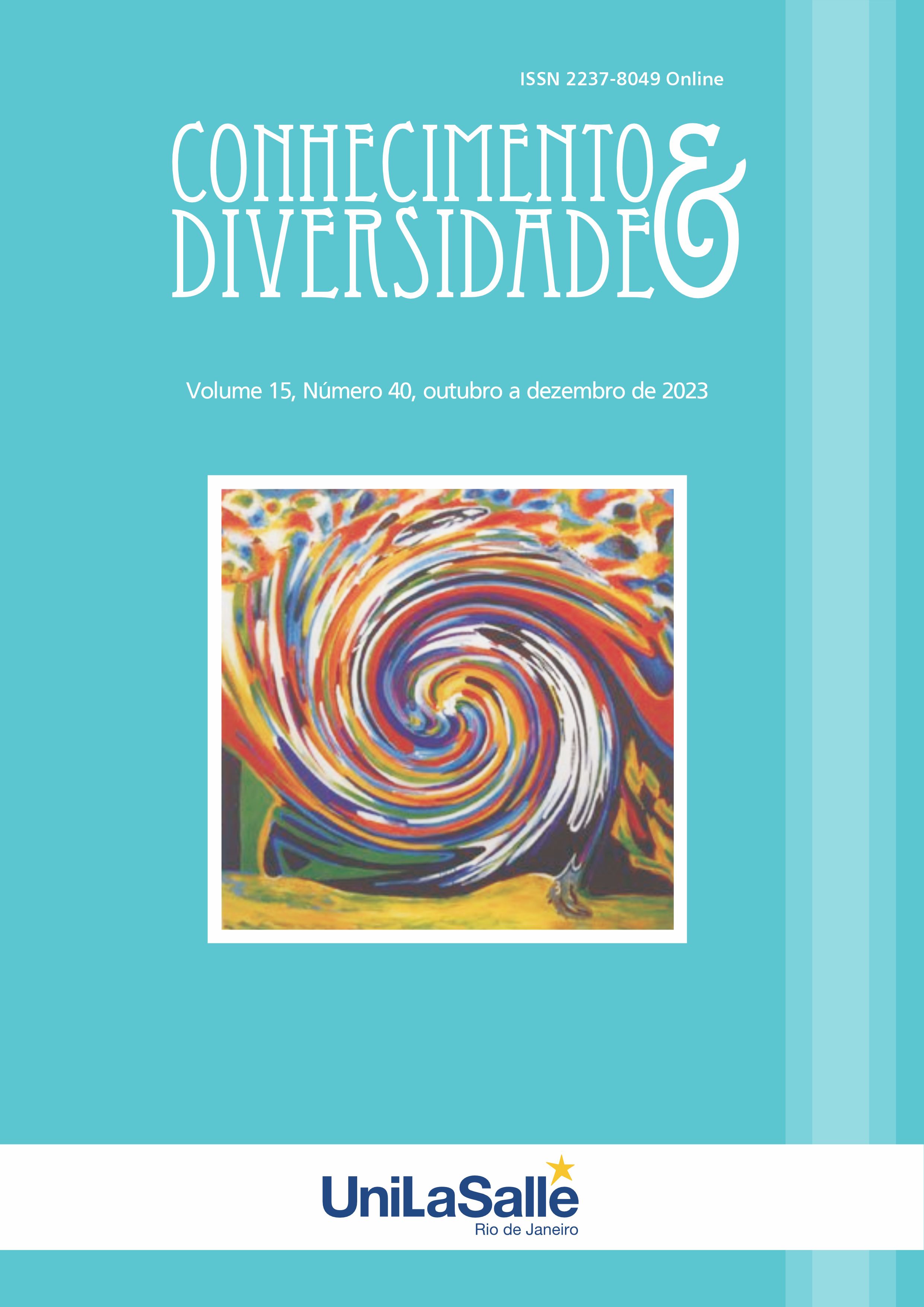UNIDADES FRASEOLÓGICAS NA LINGUÍSTICA MODERNA
SISTEMATIZAÇÃO E ANÁLISE SEMÂNTICA
DOI:
https://doi.org/10.18316/rcd.v15i40.11245Palavras-chave:
Expressões fixas, Grupos de idiomas, Construções lexicais, Expressões fraseológicas, Unidades fraseológicasResumo
O desenvolvimento da cultura da fala e dos processos de comunicação foi influenciado significativamente pela evolução da própria comunicação, marcada pela incorporação de expressões estáveis, frases e combinações lexicais fixas. Esta transformação implicou uma reavaliação do conteúdo e da mensagem pretendida pelo autor, particularmente no domínio das unidades fraseológicas. Uma área central de investigação na linguística contemporânea envolve a avaliação da qualidade do uso de unidades fraseológicas, o delineamento de abordagens de classificação e a formulação de métodos de sistematização adaptados aos atributos estilísticos e contextuais dessas construções linguísticas. Este artigo realiza um exame dos componentes estruturais inerentes às unidades fraseológicas na linguística moderna. Além disso, investiga os meandros da sua estrutura semântica, a sua utilidade contextual e as suas aplicações em diversos modos de comunicação. O artigo considera de forma abrangente as complexidades que cercam a evolução da linguagem e o surgimento simultâneo de novas unidades fraseológicas. Também aborda a influência do progresso científico e tecnológico, que contribui para o desenvolvimento de novas formas e categorias de unidades fraseológicas. A distinção na formação de unidades fraseológicas dentro de vários grupos linguísticos pode ser atribuída a uma combinação de fatores, incluindo tradições folclóricas, o legado cultural escrito, os esforços criativos da população e a transformação de paradigmas culturais. Além disso, o artigo enfatiza a importância da sistematização das unidades fraseológicas, com ênfase na obtenção de uma categorização qualitativa das construções lexicais mais prevalentes nos respectivos grupos linguísticos em consideração. Este artigo realiza um exame aprofundado dos mecanismos responsáveis pela geração de unidades fraseológicas, bem como das características distintivas na comparação de tais unidades em diversos grupos linguísticos. Também incorpora uma análise semântica abrangente que visa elucidar o conteúdo e os caminhos para a reinterpretação inerentes às unidades fraseológicas.
Referências
Adaxamjonova, M. B, Abduvaliyev, M. A. (2022). Birth and development of phraseology as a linguistic discipline in world linguistics”. Galaxy International Interdisciplinary Research Journal, 10(3), 746-752.
Davila-Montes, J. (2019). Enthymeme, metonymy, and method: comparing genre-bound rhetorical deviations between languages through corpus studies. Language and Intercultural Communication, 19(5), 407-420. Available at: https://doi.org/10.1080/14708477.2018.1545779
Godard, G., Wierzbicka, A. (2014). Words and Meanings: Lexical Semantics across Domains. Languages and Cultures, Oxford and New York: Oxford University Press, 352 p.
Hamidova, T. (2023). Study of phraseological combinations in linguistics. Scientific Collection InterConf, 161, 33-38.
Kim, M., Crossley, S. A., Kyle, K. (2018). Lexical sophistication as a multidimensional phenomenon: Relations to second language lexical proficiency, development, and writing quality. The Modern Language Journal, 102, 120-141.
Kremmel, B., Brunfaut, T., Alderson, J. C. (2017). Exploring the Role of Phraseological Knowledge in Foreign Language Reading. Applied Linguistics, 38, 848-870.
Malikova, A. M. (2022). Comparative Study of Somatic Phraseological Units in English and Azerbaijani Languages. Advances in Social Sciences Research Journal, 9(4), 236-243. Available at: https://doi.org/10.14738/assrj.94.12144
Medvedev, V. B. (2022). Extracts from the comparative description of linguistic images in the phraseological systems of Hebrew and Yiddish. Research Result. Theoretical and Applied Linguistics, 8(2), 41-51. Available at: https://doi.org/10.18413/2313-8912- 2022-8-2-0-3
Melnyk, N. I., Modestova, T. V., Krsek, O. Ye., Uschnevych, S. E. (2021). The phenomenon of ethnicity in the context of linguistics and its significance in the concept of European transcultural educational centers functioning. Journal of Language and Linguistic Studies, 17(3), 1392-1401. Available at: https://doi.org/10.52462/jlls.100
Meral, S, Kishali, E. (2020). A Study on the Intersection of Architectural History and Architectural Conservation. Uskudar Semsi Ahmed Pasa Complex Artsanat, 13, 313-334.
Mokienko, V. M., Nikitina, T. G. (2018). To the concept of a complete vocabulary of folk phraseology: Problems of macrostructuring. Lexicography Issues, 14, 80-106.
Mushaev, V. N., Abdullayev, S. N. (2017). Aspects of polysemy in Turkic and Mongolic languages (Evidence from Kalmyk and Uighur languages). Oriental Studies, 34(6), 103-110.
Odincova, T. Y., Chmyh, I. E. (2018). Stylistic aspect of translation of means of expression (metaphors, phraseologisms, epithets) based on Somerset Maugham’s novel ‘Theater’”. In Scientific dialogue: young scientist, 65-67.
Palimbetova, M. (2020). Problems of genre, artistic language, and artistic methods in Karakalpak dramaturgy during the independence period. Journal of Advanced Research in Dynamical and Control Systems, 12(6), 1037-1042.
Paquot, M. (2021). Measures of phraseological complexity: Reliability and validity. Paper presented at the World Congress of Applied Linguistics, Groningen, The Netherlands.
Radchuk, O., Krapivnyk, G., Palatovska, O., and Nekrylova, O. (2022). The verbalization of notion absence in the english language and culture. Amazonia Investiga, 11(52), 6-14. Available at: https://doi.org/10.34069/AI/2022.52.04.1
Saidova, Z. (2022). Modern Methods of Translating Phraseological Units. Eurasian Research Bulletin, 4, 153-158.
Singleton, D., Leśniewska, J. (2021). Phraseology: Where Lexicon and Syntax Conjoin. Research in Language and Education. An International Journal, 46.
Syzonov, D. (2018). Media Phraseology and the Dynamics of the Ukrainian Language: The Psycholinguistic and Stylistic Paradoxes. Psycholinguistics, 24(2), 277-291. Available at: https://doi.org/10.31470/2309-1797-2018-24-2-277-291.
Zho, H. (2020). Making a stance: social action for language and intercultural communication research. Language and Intercultural Communication, 20(2), 206-212. Available at: https://doi.org/10.1080/14708477.2020.1730393
Downloads
Publicado
Edição
Seção
Licença
Copyright (c) 2023 Mariya Veresh, Nataliia Demianenko, Olha Rud, Natalia Bytsko, Svitlana Nastenko

Este trabalho está licenciado sob uma licença Creative Commons Attribution 4.0 International License.
Conforme recomendado pelo o Public Knowledge Project, a RCD adota para seus artigos uma licença CREATIVE COMMONS: Atribuição CC BY 4.0.
Esta licença permite que outros distribuam, remixem, adaptem e construam sobre o seu trabalho, mesmo comercialmente, desde que lhe dêem crédito pela criação original.
Esta é a licença mais adequada oferecida.
Recomendado para a máxima divulgação e uso de materiais licenciados.



